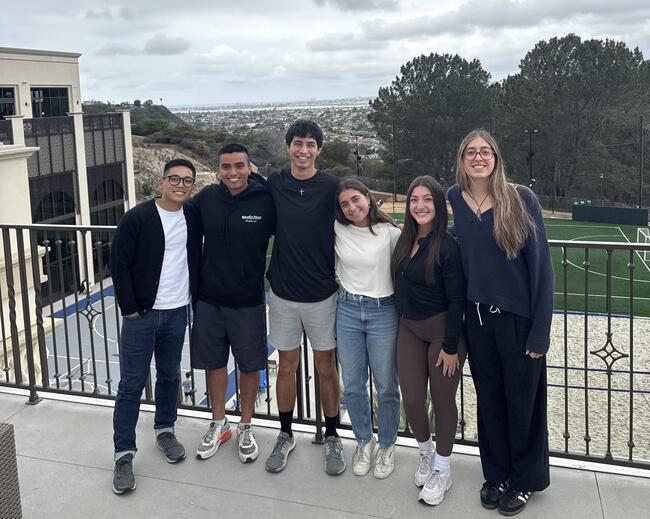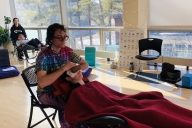You have /5 articles left.
Sign up for a free account or log in.

Each of USD’s student wellness ambassadors has a designated role and focus area targeting an element of student well-being.
University of San Diego
Mindful of the role student mental health plays in persistence and retention, colleges have created new facilities and services to encourage them to focus on their well-being.
Inside Higher Ed’s 2024 presidents’ survey found that 70 percent of respondents said their institutions have invested in wellness facilities or services to promote student physical and mental health.
The University of San Diego officially opened its new Palomar Health Student Wellness in April, named for their partnership with the health-care provider Palomar Health. The center houses fitness classes, relaxation spaces, a teaching kitchen and practice facilities for varsity athletes.
To help ensure that the sparkling-new center doesn’t remain untouched, the university is recruiting student leaders to serve as wellness ambassadors for the facility and other campus resources.
What’s the need: Prior research shows that while campuses provide a variety of support services, many students remain unaware of the resources or don’t take advantage of all the offerings. A 2023 survey found that while 73 percent of college staff said a student health clinic was available on campus, only 33 percent of students knew about it.
When Kimmel Yeager, the executive director of the Palomar Health Student Wellness Center, first stepped onto USD’s campus, she said she was excited to lead efforts regarding wellness because the university provided so many services. But it quickly became clear to her that she faced a daunting task in promoting their use.
“I was just instantly overwhelmed; how do I get that information as a new employee? Where do I go?” Yeager said. “Then I’m talking to students, and I’m so excited … and they were like, ‘Yeah, we never know where to go.’”
So Yeager established a small group of student leaders to spearhead communication and promotion of resources for their friends and classmates, as well as educate them on relevant topics. The goal wasn’t to replace student groups or organizations that provide subject matter experts in various fields, but to build campus awareness of the range of services offered.
“We need some students who know everything that’s going on … because they’re out in the community, they’re in their student organizations, they’re in their residence halls, they’re in their academic settings and they can be a voice to their peers,” Yeager said.
How it works: USD’s inaugural cohort of student wellness ambassadors have worked in wellness-focused positions on campus, such as the counseling center or fitness facilities, or in a health-focused major with aspirations to pursue a career in wellness. The program is modeled on USD’s Alcalá Club, a group of student leaders who serve as envoys for the university in formal settings, typically interfacing with alumni and donors.
Survey Says
A 2023 Student Voice survey by Inside Higher Ed and College Pulse found that one in four respondents believe their campus wellness facilities need improvement. An additional 23 percent said wellness class offerings could use work, and 18 percent said the same about fitness facilities. But the most commonly identified area for improvement was dining hall food options, cited by 45 percent.
Student ambassadors represent various forms of wellness—physical, mental and spiritual—and include both undergraduates and graduate students pursuing a wide range of studies.
In 2024, student leaders created the foundational elements of the club, writing a constitution, establishing a learning platform and designating leadership positions for the upcoming year.
Kaleena Jezycki, a second-year graduate student in USD’s accelerated nursing program, became interested in the program as a way to break out of her own discipline and get more involved on campus.
“We really want our wellness ambassadors to be a face on campus and a face that’s known, like, ‘Hey, I can come to them for resources, or they’ll know what’s going on. They’ll know how I can get some help,’” Jezycki said.
Yeager sought to select student ambassadors who could combat misleading health trends that may be popular on social media but don’t necessarily align with research. Still, the center doesn’t have a fixed idea of what wellness should look like and students can engage in a variety of supports, including Indigenous medicine, plant medicine and healing with energy.
Ambassadors also hope to remove the trepidation students may feel about visiting the new facility by promoting it through tabling events, fliers, social media posts, word of mouth and leading by example.
“It’s easier to want to go do it when you see someone like you using it, versus, like, the faculty is telling me to do this,” Jezycki said. “It makes it more welcoming and encouraging for students.”
What’s next: Staff and student ambassadors hope to encourage more students to engage in self-care habits that they can take into the rest of their lives—not just by being physically active but also by learning to cook for themselves, identifying helpful coping mechanisms and exploring the various avenues of well-being.
Student leaders are empowered to lead and direct events, as well as determine the focus of wellness promotion on campus, which Jezycki said has allowed the program to remain adaptable and relevant to today’s students’ needs. “This isn’t just a typical advocacy group but a leadership group that has the potential to make a direct impact on the lives and wellness of our students. Our voices as wellness ambassadors are truly heard.”
Do you have a wellness intervention that might help others promote student success? Tell us about it.




